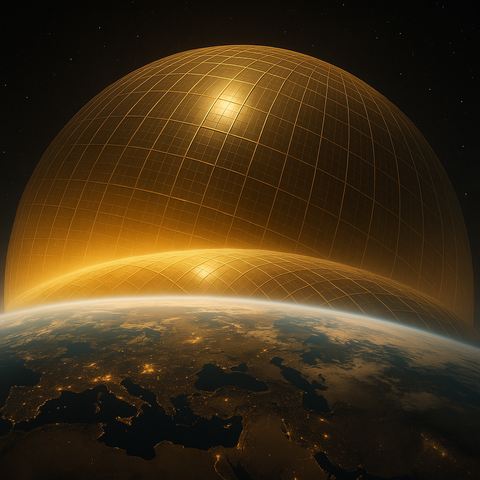The Golden Dome: America’s Next Great Gamble in Space?
The Golden Dome: America’s Next Great Gamble in Space?
A citizen-journalism look at the promise and pitfalls of a planetary-scale orbital “dome”: economics, Pentagon and Space Force roles, commercial interests, timelines, costs, feasibility — and the politics that frame it.
WordPress AI image of “Golden Dome”By DrWeb, your fearless Editor, and aided on his left hand by ChatGPT. My co-partner has provided the outline, and research, and drafts. I have reviewed and edited the AI. –DrWeb
A shimmering dome high above Earth — not myth but ambition. Defense planners describe layered orbital infrastructure to protect satellites and enable new industries; investors see a catalyst for the next space economy. To the public, the phrase Golden Dome blends awe with skepticism: moonshot or mirage?[1]
The idea traces to defense and commercial studies on satellite resiliency, optical/laser links, and power-beaming. The imagery stuck in politics when “a dome of safety” or “Golden Dome” branding surfaced in speeches and statements — amplifying public attention and investor curiosity.[2]
Economic “Gold Rush” — Promise vs. Speculation
Proponents argue the Dome would ignite new sectors: orbital fabrication, autonomous repair drones, debris remediation, laser/optical relays, and energy transmission. Government demand could accelerate private R&D and high-skill jobs nationwide.[3]
Critics warn of speculative bubbles and cost overruns. Credible comparators show how fast costs scale: NASA’s Artemis campaign ~$93B through FY2012–2025; Apollo ~$257–318B in today’s dollars depending on index. A dome-like mega-constellation could outstrip even those benchmarks depending on scope and governance.[4]
Pentagon & Space Force: Deterrence or Arms Race?
Advocates inside the Department of Defense frame a dome-style architecture as layered deterrence: hardening comms, navigation, missile warning/tracking, and cislunar awareness. The U.S. Space Force would likely run command-and-control with AI-assisted monitoring and autonomous servicing.[5]
Concerns persist: dual-use ambiguity, debris proliferation, power-beaming safety, and treaty friction (Outer Space Treaty/OST; Liability Convention). Detractors warn rivals could read the Dome as de facto weaponization, accelerating a new space arms race.[6]
Commercial Interests: Who Builds, Who Owns?
Prime contractors and “new space” firms pitch enabling pieces: mass launch, optical interlinks, mesh networking, refueling depots, debris capture. The Space Development Agency’s proliferated architecture (data transport + missile warning/tracking) shows how government constellations are already scaling with industry partnerships.[7]
Governance knot: The OST forbids national appropriation of space, yet licensing and IP regimes can confer de facto control. If public funds seed the Dome, what’s the public’s guaranteed access and price discipline?[8]
Timeline & Cost Estimates
Budget brackets: treat any $0.5T–$2T figure as scenario planning, not a commitment; the only well-audited analogs (Artemis, Apollo) already sit in the tens/hundreds of billions and highlight compounding schedule/cost risk for megaprojects.[10]
Feasibility Check: Technology, Debris, and Policy
Independent assessments flag four choke points: (1) power generation/transmission (SSP progress is real but early), (2) debris avoidance and remediation at constellation scale, (3) cyber-resilience of orbital meshes, (4) sustained bipartisan funding and crisis stability. Expert studies recommend pacing advances while strengthening space safety, governance, and deterrence frameworks before attempting megastructures.[11]
Trump’s Position: “Shield of Peace” Framing
Donald Trump has described a protective “dome” for the United States — variously dubbed an “impenetrable” or “Golden” dome — and linked it rhetorically to Space Force and strategic dominance. Supporters view this as vision-setting for accelerated resiliency; critics say the branding outpaces formal doctrine and line-item plans.[12]
Bridge: Pattern Recognition — Vision or Mirage?
Context, not slant: several high-profile Trump ventures (e.g., Trump University, Trump Airlines, Truth Social, segments of border-wall contracting) launched with bold imagery but uneven execution. Analysts see echoes in a Golden Dome pitch: spectacle catalyzes attention, but engineering, governance, and financing determine survival. Counterpoint: the same showman’s pressure sometimes moves institutions — Space Force did materialize. The open question is whether this concept is a strategic leap or a mirage glittering beyond reach.[13]
Closing Reflection: Gold or Gilded?
The Golden Dome concentrates America’s oldest tension — dream vs. discipline. If it rises, it will rest not only on launch vehicles and laser links, but on public trust: transparent costs, enforceable oversight, and international guardrails. Until those foundations harden, the Dome remains a brilliant possibility suspended in the thin air between aspiration and proof.
Notes & Sources
#AnotherTrumpGamble #Bubble #CommercialInterests #Costs #Feasibility #GoldenDome #Mirage #OribalMechanics #Pentagon #PieInTheSky #PlanetaryScale #Politics #ProtectEarth #Science #Space #SpaceForce #Timelines #Trump













